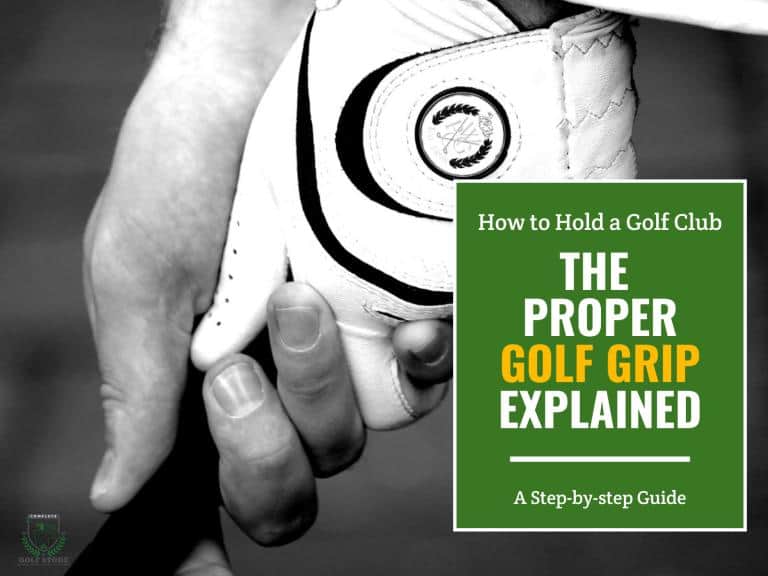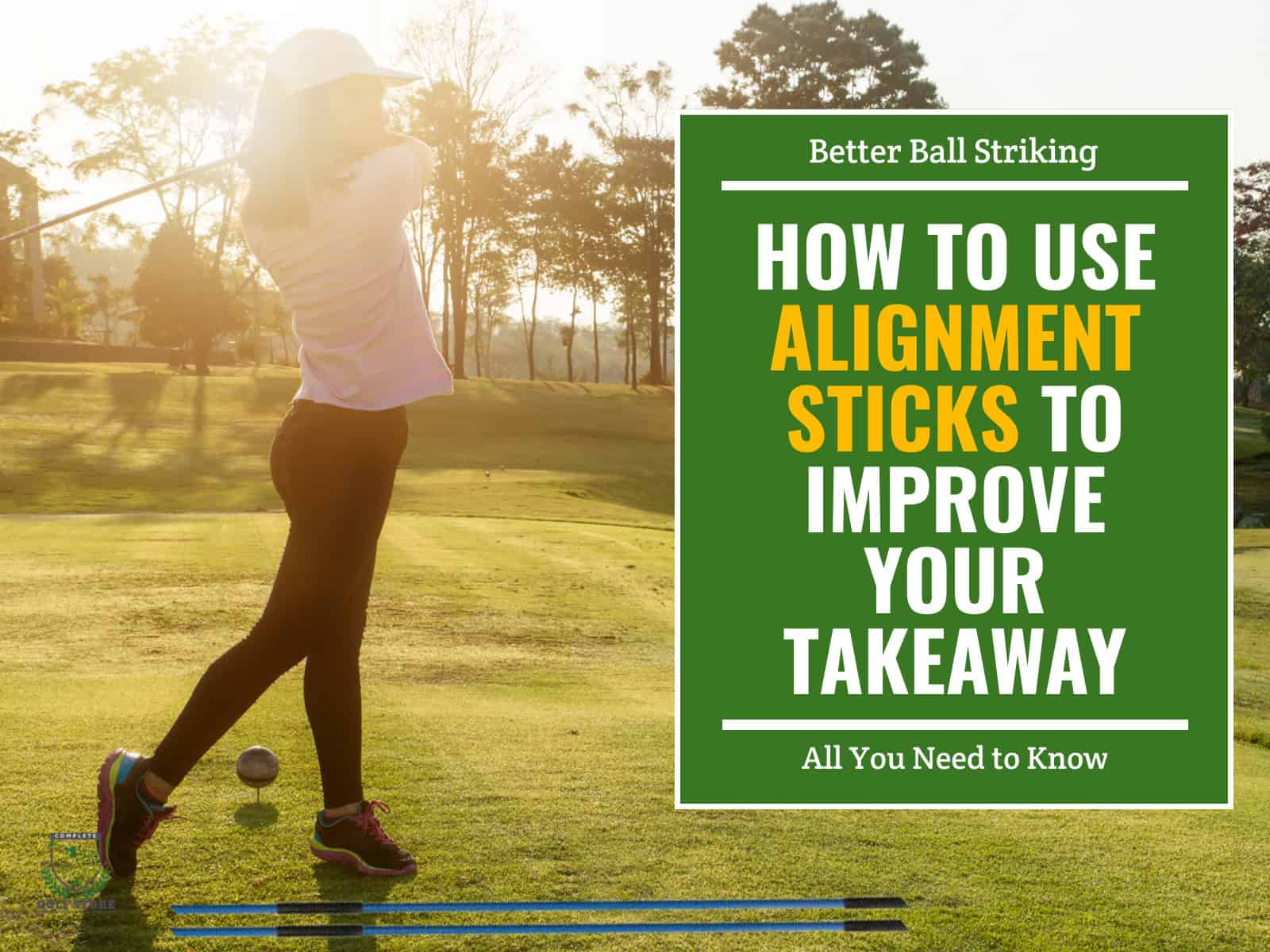The way you hold your golf club will determine the quality of your swings as well as the outcome of the rounds you play (in addition to your swing path and ball flight)!
Your golf swing starts with your grip. If you hold your club incorrectly, it can cause many problems. You may feel pain or discomfort in your hands, wrists or arms. This could lead to bad shots, failed out-of-the-bunker shots, missed putts, incorrect chips, and even injury. An incorrect grip is one of the most common bad habits that many beginners and high handicappers have.
In this article, we will explore golf grip thoroughly. We will explain the proper grip and give you tips on how to improve your golf swing. We will provide you with everything you need to master to swing like a pro!
- 1) Why Is the Proper Golf Grip Important?
- 2) How to Grip a Golf Club? Step-by-Step Guide for Beginners
- 3) How Do You Know If You Have a Proper Golf Grip?
- 4) Different Styles of Golf Grips
- 5) Overlapping vs. Interlocking Golf Grip – Which Is the Best?
- 6) What Is the Proper Way to Hold a Golf Club?
- 7) Grip Pressure: How Hard Should You Grip the Golf Club?
- 8) Strong, Weak, or Neutral Golf Grip. Differences and Which Is Best for You?
- 9) How to Hold a Golf Club for Left-Handed?
- 10) How Far Down Should You Grip a Golf Club?
- 11) Should You Have the Same Golf Grips on All of Your Clubs?
- 12) How Often Do PGA Touring Pros Change Their Grips?
- 13) Conclusion
Why Is the Proper Golf Grip Important?
There are a plethora of reasons why a proper grip is essential to the quality of your overall game. Some of these reasons include the following:
Improving Your Swing
Holding a club correctly improves your ability to make solid contact with the ball. It helps you hit it straighter, which means less effort is required to get the same distance.
A good swing requires accurate timing and control over your body movements. This will result in a more consistent golf swing tempo and speed. When you have a correct grip, you will be able to execute those movements quickly and efficiently.
We do have a detailed guide on Golf Swing Basics for Beginners if you are interested in knowing everything about the intricacies of the swing.
Better Accuracy
Holding a club properly makes it easier for you to aim accurately at the target. When you hold your club correctly, you will not have any difficulty lining up your shot. In addition, you will be able to keep your eyes focused on the ball throughout the entire swing.
Reducing Injury
If you hold a golf club incorrectly, you may cause strain on your muscles and joints. In addition, an improper grip on your club can sometimes cause soreness in your hands, wrist hinge, and forearms. These areas are usually affected by wrong grips because they are used constantly to maintain balance while swinging.
Improved Hand Strength
Holding a golf club right allows you to use your hands effectively. By doing so, you will be able to develop stronger fingers and palms. Stronger hands mean better accuracy and power when hitting the ball.
Go ahead and read the article on how to play golf. The article also emphasizes why a good grip is vital for a successful round of golf.
How to Grip a Golf Club? Step-by-Step Guide for Beginners

If you are a beginner who has just picked up golf, perfecting your grip can be an overwhelming challenge. Luckily, we’re here to help you out with simple steps that can improve your grip and overall game:
Step 1
First off, make sure your club is straight, with the club head pointing upwards. You can do this by using the markings on the handle; these are usually aligned with the club head. If the writings (and notches) on the handle are facing upwards, then the club head is straight.
Step 2
You need to ensure that you have a firm grip on the handle of your club. Do not apply too much pressure when gripping the club. Too much force applied to the handle can cause the shaft to bend or break during the swing.
Also, a weaker grip will cause club control and ball direction issues. Instead, try to place just the correct grip pressure on the handle without squeezing your golf club to death. Bear this in mind throughout the whole process.
Step 3
Next, place the palm of your top hand (If you are a right-handed golfer, this is your left hand; but it is the right hand if you are a left-handed golfer) next to the handle, facing inwards while keeping it straight. This feels like a more natural grip for any golfer (compared to the palm facing down or upwards).
Step 4
Now, as your palm approaches the handle, make sure that the club touches the base of your little finger and the middle of your left index finger (the opposite if you are a lefty). After that, wrap your fingers around the club handle. You should not cover the top of the handle, and your thumb must be aligned with the markings and the club head. When the club is held in front of you and leveled to the ground, your thumb and index fingers should form a crease with an angle pointing towards your right shoulder (or left shoulder if you are left-handed).
Step 5
Make sure the crease of your top hand, as well as the knuckles of your index and middle finger, are visible. The process of bringing your bottom hand closer to the club is similar to the steps followed with the top hand, with a few minor differences. It must be straight, facing inwards (the side of the handle). Your bottom hand must be placed against the thumb of the top hand. Then, wrap the fingers around the grip. The lower part of your bottom hand thumb needs to be placed on your top hand thumb.
Step 6
Now that you have both hands gripping the club handle, you need to make sure the creases of both hands (formed by the thumbs and indexes) are pointing towards your right shoulder (if you are left-handed, they will be facing your left shoulder).
Step 7
To ensure that you are holding the club correctly, practice this new grip several times before playing a round. Once you feel comfortable with the grip and don’t notice any problems with the ball direction, you should be ready to play!
Please note that the above steps are for a neutral grip that will suit the majority of golfers. It is also a simple method that can be used with all your clubs (with the exception of putters).
To further simplify the steps, we suggest you watch a video (8 minutes) in which former professional PGA golfer Rick Shiels shows how to hold the club properly:
How Do You Know If You Have a Proper Golf Grip?
You can use certain checkpoints while practicing your grip (and swing) to check whether or not you have a proper grip. Some of those are listed below:
- Your grip should be firm. If you feel any looseness or weakness in your grip, then you need to work on improving your grip pressure and strength.
- The position of your hands should be parallel to each other. If they aren’t, then you need to adjust them accordingly.
- Your hands should be positioned at a 90-degree angle from your body. If your hands are too far away from your body, then you need to move them closer.
- Your elbows should be slightly bent.
- Your wrists should be relaxed. If they are stiff, then try to relax them.
- Your shoulders should be relaxed too. If you feel tension in your shoulders, you need to release it.
- Your back should be straight. If you feel discomfort in your back, you need to correct it.
- Your eyes should be focused on the ball.
- Your head should be aligned with your spine, not tilted forward or backward.
- Your feet should be flat on the ground. If you feel any discomfort in your feet, you need to fix it.
- If you feel any pain when using your hands, you need to stop doing what you were doing until you get rid of the pain.
Additionally, your whole grip must feel natural; if it feels unnatural, you are doing something wrong. Finally, ball flight is related to your grip, too: If you manage to hit straight shots, your grip is good, but if you struggle with ball flight and direction, then there is something that needs to be fixed.
Different Styles of Golf Grips
There are different ways of holding a club that can be used by golfers in their search for the perfect grip. We will be exploring the three most popular grip styles (and most basic types) to give you an idea about all three. In the end, it’s a matter of personal preference; whichever style feels more comfortable and natural to you is the one you should adopt and use.
Vardon Overlap Golf Grip
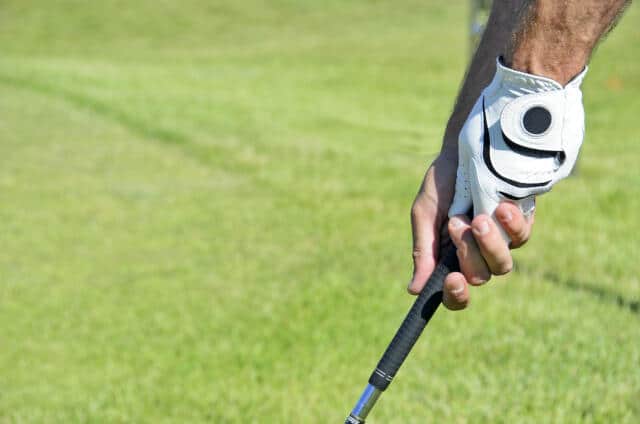
The overlapping grip is probably the most popular one among golfers worldwide. It is also called the ‘Vardon grip’ as a reference to the British golfer that first discovered (in the early 20th century) this new technique that revolutionized golf: Harry Vardon. The overlap grip has been used by some professional golfers like Ben Hogan, Phil Mickelson, and Arnold Palmer.
Check also: 14+ of The Greatest Golf Rivalries and feuds in History
If you are a right-handed player using the Vardon overlap grip, your two hands should be slightly overlapping. In fact, the little pinky finger on your trail arm (bottom hand – the right arm in this case) slightly overlaps with the index of your leading arm (top hand – your left arm).
The Vardon overlap grip is very popular for a reason! (many reasons, to be fair). For example, it combines control and freedom. The two wrists and hands are still free, but they perform as one, providing more control and accuracy for a better shot, without necessarily sacrificing too much power and distance. Also, it is more comfortable and suitable if you have big hands, as the two hands overlap and do not just wrap around the club handle.
The only drawback the Vardon grip has is that it may be uncomfortable for people with small hands; it also sacrifices a bit of the power transfer (compared to the 10-finger grip- discussed below).
Interlocking Golf Grip
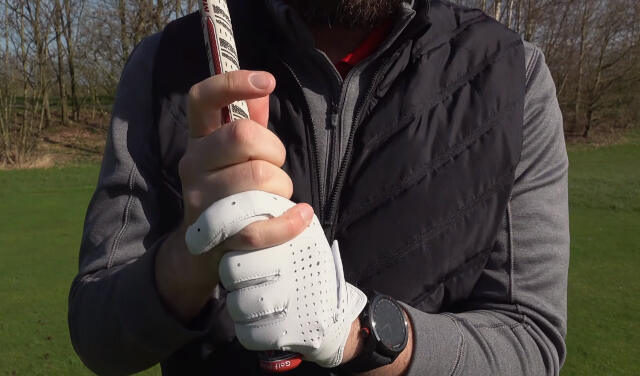
The interlock grip is another popular grip. This is different from the Vardon overlap grip in that Instead of having the two hands slightly overlapping each other, they completely lock together. the index finger of the leading (top) hand is positioned in between the ring and pinky finger of the trailing (bottom) hand.
This is the best choice for those who want maximum power transfer and maximum comfort. It helps build up swing speed. However, it does sacrifice some accuracy and control. It is favored by many big names in the golf world including Tiger Woods, Jack Nicklaus, Tom Kite, Michelle Wie, and Rory McIlroy, among others.
The interlock grip is great for players with smaller hands, such as children and female golfers. It is also ideal for players who prefer a stronger swing because the hands work together as one unit to provide extra strength from the arms to the club.
However, it is less suited for players with big hands, as it may feel a bit awkward and unnatural (especially for new players). Also, the interlocking grip requires a lot of practice to master.
10 Finger Golf Grip
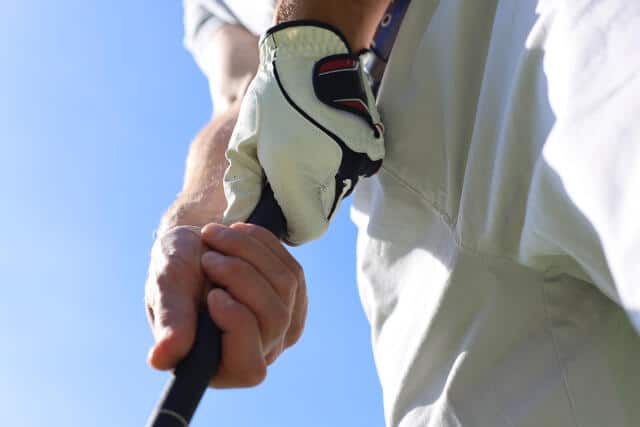
This type of grip is the most basic of the three styles. Its naming is also simple: All ten fingers are touching the club. The lead hand (top hand) is on the top part of the handle, while the trail hand (bottom hand) is immediately below it. The little finger on the trail hand is touching the index on the trail hand without any kind of overlapping. Sometimes, it is also referred to as ‘the Neutral grip’ or ‘the baseball grip’ because of how close it is to the way you hold a baseball bat.
The ten-finger grip is very easy to use, especially for beginners and amateur golfers. It also feels very natural and allows for more power transfer because all ten fingers are in contact with the club and transfer more power from the arms. As a result, the 10-finger grip can help achieve more powerful shots and distances.
However, this grip style allows too much freedom in the wrists, which can eventually affect control and accuracy (even though it helps with speed and power). Moreover, since the two hands are not really connected, this means that they can operate independently, which can cause a power imbalance and mess up the whole sequence of your swing, resulting in poor shots.
In the end, no matter which grip you choose, there are mistakes that must be avoided at all costs. The following video (6 min. 54 sec.) exemplifies some of those killer mistakes; of course, wearing gloves can help you have a better grip; we suggest going through our selection and reviews of the Best Golf Gloves available in the market.
Overlapping vs. Interlocking Golf Grip – Which Is the Best?
Now that we know how each type of grip can be executed, we need to compare the two most widely used grips: Overlap Vs. interlock. Let’s face it, the ten-finger grip can be very useful for beginner golfers, as it helps them achieve longer shots; however, if you are serious about improving your game, you will probably need to switch to one of the other grips simply because of the much more control and accuracy they provide.
Most golfers that adopt the interlocking grip do so because the two hands are firmly connected together and feel like one unit, which increases the power of the swing and may benefit distance (in addition to the control that is provided, compared to the 10-finger grip).
The same thing goes for the overlap grip. Again, the goal is to connect the hands and improve accuracy and control. However, since the hands are not as strongly connected in the overlap grip as in the interlock, it seems that control may be affected.
Also, as mentioned earlier, the interlocking grip is more suited and comfortable for players with smaller hands, while golfers with larger hands may feel more comfortable using the overlap grip.
In the end, there is no way for us to say which grip is best for you. You need to try each one and see which feels more comfortable and allows you to stay connected throughout your swing.
It’s all a matter of personal preference: Choose a grip that works for you!
What Is the Proper Way to Hold a Golf Club?
So far, we know that each player has to choose a specific grip that works for him/her. It all depends on what the objective is: Distance, accuracy, etc.
Best Golf Grip for Distance
If your goal is to achieve the longest possible distance, then the grip to choose is the interlocking grip. The reason is that the hands are so firmly locked together with less effort. You don’t need to press on the club too much to keep it in place (regardless of having a strong or weak golf grip).
As a result, the muscles and forearms are more relaxed when using an interlocking grip, which can increase your clubhead speed without losing control of the club. Higher clubhead speed translates into longer distances.
Best Golf Grip for Accuracy
If you wish to improve accuracy, then you should probably opt for the overlap golf grip. The reason is that the hands are connected and feel like one unit, which provides better control than the ten-finger grip. However, wrist movement is not restricted, and your wrists are freer to move (compared to an interlock).
Overall, the overlap grip combines both control and freedom, resulting in more accurate shots.
Best Golf Grip for Beginners
The answer here is probably obvious: As a beginner, the best grip to use is the ten-finger. It is the simplest type of grip and doesn’t require too much time and effort to master. You can literally master it in a few days.
Moreover, the ten-finger grip helps transfer much more power from the arms to the club because the ten fingers are contacting the club handle. Therefore, it is the best grip to use as a beginner!
Grip Pressure: How Hard Should You Grip the Golf Club?
How much are you supposed to press on the golf club handle? Well, this really depends on your strength and physical condition. In general, though, the pressure applied by the hand should be sufficient enough to prevent the club from slipping out of your hands during the swing.
However, some people tend to apply too much pressure on the club handle, especially beginners. This results in a loss of control over the club. So, instead of applying excessive pressure, you should focus on maintaining proper posture and alignment.
Basically, you should treat your club like a bird (that you are keeping in your hands). Your grip needs to be strong enough to prevent the bird from escaping through your hands but not too firm to the point of crushing the little animal. It’s a bit of a weird analogy, but it does give us an idea of how much pressure we need to apply on the golf club!
Strong, Weak, or Neutral Golf Grip. Differences and Which Is Best for You?
A lot of new players may get confused by the terminology used in golf. For example, in addition to the types of grip that we discussed earlier, we can also classify a golf grip as either strong, weak, or neutral!
First off, the three terms do not refer to how strong a golfer holds the club; rather, they refer to how the hands (and clubhead) are rotating. Simply put, with a strong grip, both hands are slightly rotated away from the target direction (Strong grip position); A weak grip means that the hands are a bit rotated toward the target (in a weak position), and a neutral grip is somewhere in between the two (the hands are in a neutral position).
A strong golf grip helps keep the clubface square to the target line throughout the entire backswing and downswing (and a square clubface at impact). It can also help you fix golf hooks. On the other hand, a weak grip allows for greater rotation of the hands and thus the club head.
In fact, most professional golfers prefer using a strong grip when swinging the club (even though some, including Tiger Woods, are a tad on the weaker side). They believe that such a grip gives them more control over their swings and encourages longer distances.
However, if you have trouble controlling your swing, then you might want to try experimenting with different grips to find the best one for you.
In summary, a strong grip will help you maintain better balance and control over your swing, while a weak grip will allow you to rotate your hands more freely. A neutral grip will fall somewhere in between the two extremes.
The following video (10 minutes 11 seconds) from Top Speed Golf explains the three types of grip in more detail:
How to Hold a Golf Club for Left-Handed?
A left-handed person will find it easier to swing the club left-to-right instead of right-to-left. If you’re a lefty like me, you might consider getting a set of clubs specifically designed for lefties. This will give you a more balanced feel when you swing them and prevent you from having to use a club that was meant for right-handed people. These clubs are available in most sporting goods stores and online from sites like Amazon.com.
After you ensure that you have the right gear for a left-handed golfer, you simply need to follow the instructions mentioned before, but with a few changes: Everything must be reversed: leading arm, trail arm, top hand, bottom hand, etc. All the techniques are the same, though!
For example, your lead arm and top hand will be the right ones, while your bottom hand and trail arm will be the left ones. You will need to wrap your right hand around the club handle before the left one. In a nutshell, you will need to do the opposite of what a right-handed golfer would (and we tried to point it out throughout the sections above).
If you’re a lefty like me, you might consider getting a set of clubs specifically designed for lefties. This will give you a more balanced feel when you swing them and prevent you from having to use a club that was meant for right-handed people.
How Far Down Should You Grip a Golf Club?
When it comes to golf grip, the most essential condition is comfort and effectiveness. Even though there are certain specific styles you can use to have a better grip, it all comes to personal preference. Use whatever works for you and feels more natural and comfortable.
However, it is widely agreed that you shouldn’t hold the very top of the club handle, as this can affect your shots and control. You might end up hitting the balls with the heel of your club.
Instead, try to keep your upper hand at around one inch away from the handle top. Some players may feel more comfortable holding the club 2 to 4 inches away. This allows you to maintain a firm grip on the club while still having plenty of room to let your hands swing freely through your shots.
It’s important to remember that this will vary from person to person, so grip the handle of the club as far down as feels comfortable to you! If you struggle with maintaining your grip, try practicing with your club to find the grip that suits you.
Should You Have the Same Golf Grips on All of Your Clubs?
If you use the overlap grip, then the answer may be yes! Even while putting, you can use the same conventional grip on all your clubs. This grip style is used by around sixty-eight percent of professional tour players (including Jason Day and Tiger Woods).
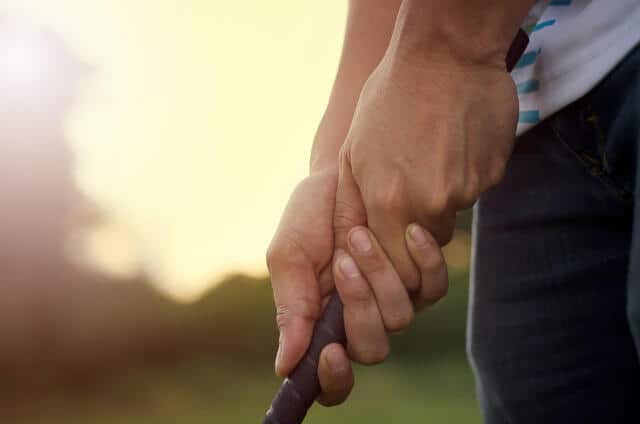
Another grip that is widely used for putting is a slight variation of the conventional grip: the left hand down (also called the cross-handed grip). The left hand (for a right-handed player) is moved a bit lower than it is in a conventional grip. This one is adopted by almost thirteen percent of tour players (Alex Noren, Jordan Spieth, etc.).
You may also opt for the claw grip on your putter. This one is used by about nine percent of tour players (Tony Finau, and Justin Rose, among others). It consists of having the dominant hand doing nothing but supporting the side of the club. The dominant (lower) hand is kept straight and doesn’t wrap around the club; it only helps support the club from the side.
The arm lock grip (5.8%) is another putting grip in which the club is held at the lowest point of the handle, while the upper part rests on the forearm, which helps lock the club and ensure it is moving with the arms as one unit (Used by Matt Kuchar, Bryson DeChambeau, etc.).
A variation of this grip (arm lock) is the arm lock with the claw (2.8% – used by Webb Simpson); it’s a combination of the two putting grips: Using a claw grip at the lowest part of the handle with the forearm locking the upper part.
Around 1.4% of tour players use the Broomstick grip for putting (1.4% – Adam Scott). The name gives it away: The thumb of your left hand (if you are right-handed) rests on the very top of the club handle while the other fingers wrap around it. Your right hand is much lower on the club shaft, which makes it very similar to how you hold a broomstick!
These are the most common putting grips that are used by some of the most renowned tour players around the world. You can try every single grip and see which one is best for you!
For a detailed guide on Proper Putting Grip and how to choose the one that best suits your putting style, check out our guide on how to hold a putter.
If for some reason, you can’t try different putting grips, we suggest you follow the instructions of one of the best golf instructors in the world! In the following video (3 minutes 21 seconds), David Leadbetter will teach you what he thinks is the best way to grip a putter:
How Often Do PGA Touring Pros Change Their Grips?
This question is a little ambiguous, as it can be understood in two different ways: Are we talking about re-gripping the clubs or changing the way one holds the clubs? Still, it will be helpful to provide answers to both questions.
Concerning the grip style, we always recommend experimenting with different styles until you find the one style that works for you. Once you find the grip that works for you, it is always recommended to stick to it, as changing it can sometimes make your game worse! That’s why every PGA pro golfer is known for adopting a single grip, one that helps him/her achieve the best optimal results. If you can remember, earlier, we did mention some PGA professionals when talking about different grip styles and putting grips. A consistent grip is essential to successful rounds.
When it comes to re-gripping one’s clubs (changing the physical grips on the clubs), it all depends on many factors: How often the clubs are used, the degree of wear, etc. For an occasional golfer, grip changes need to be done every 30 to 40 rounds (even practice sessions count as entire rounds); That’s the equivalent of 12 to 18 months of use. The grips may need to be replaced more often if the player lives in a humid or particularly hot area.
On the other hand, a professional golfer uses his/her clubs much more often, which causes faster wear and tear of the grips. Usually, a PGA tour professional player will need to replace the club grips every six weeks to two months. This is because a pro golfer uses his/her clubs almost on a daily basis and needs to have everything (grip size, condition, etc.) to be good so as to have the perfect grip, which affects the quality of the swing and overall performance.
Conclusion
The proper grip is an important part of the swing and is essential for the most consistent results. When you’re holding a club correctly, you’ll have the ability to hit the ball with less effort and more accuracy. As a result, your grip has an effect on your performance and, ultimately, the outcome of your game. A grip could cause a sudden decline in your performance and ruin your game.
In this article, we went through the most popular grip styles used by the world’s most renowned professional PGA golfers. We also provided simple guidelines for any golfer to test different grips and see which one(s) work best for them. We just provided everything you need to know to have the perfect grip.
In the end, it’s your choice to make: You need to adopt the grip that works best, feels more comfortable, and helps you get better results. If you are a beginner golfer, then there is a lot of testing and learning to be done before you can confidently decide which particular grip is the best for you.
If there are any questions or comments, make sure you contact us or leave a comment below. We will do our best to assist you the best and as soon as we can!


